Ancient Corinth
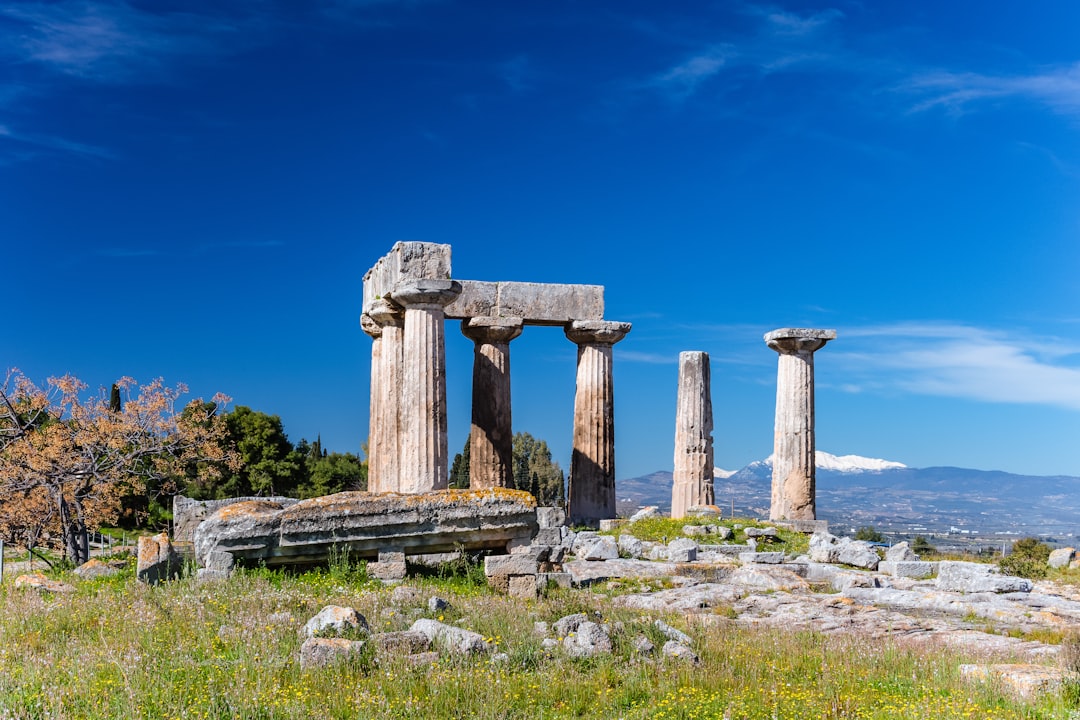

Archaic Temple (Apollo)
Even though you just began your tour, this is an iconic symbol of Ancient Corinth. So be sure to take a photo in front of the temple. The structure is labelled the Archaic Temple due to its age. It was built originally in the mid-sixth century BC.
The temple contained two internal rooms, though they were not of equal size. Most scholars believe that the smaller of the two rooms was used as a treasury. In the first century AD, the sixteen columns placed within these internal rooms were repurposed for use on the Roman Forum. New columns were built in as a part of a colonnade surrounding the temple.
Pausanias (second century AD) described the temple as a place of worship to Apollo. The archaeological evidence located in this regard would support this ancient description, so much so that many simply refer to the structure as the Temple of Apollo. Two other edifices to Apollo were also mentioned by Pausanias, and the connection is an important one for understanding the New Testament.
In nearby Delphi, the cult of Apollo was very prominent. There priestesses received divine revelation which resulted in ecstatic utterances and prophecies. The apostle Paul expressed concern about outsiders entering the meeting of Christ-followers and becoming confused as to which deity was being worshipped: "So if the whole church comes together and everyone speaks in tongues, and inquirers or unbelievers come in, will they not say that you are out of your mind?" (1 Corinthians 14:23). The prominence of the cult of Apollo and the connection of Corinth to Delphi may explain this concern on the part of the apostle.
Glauke Fountain
This fountain was remodeled extensively by the Romans. It contained four cisterns, which were filled from another water source (probably from the acrocorinth). A small structure was built over the rock in the time of the apostle Paul. The visual effect of this in the time of Paul would have been water flowing from a rock.
Paul makes an interesting reference to water flowing from a rock when discussing baptism and the Eucharist (1 Corinthians 10:4). The apostle is likely referencing the account of Moses striking the rock in the wilderness (Exodus 19:7). Nevertheless, the Corinthians who received his letter would have undoubtedly appreciated the use of water as religious symbolism. Early Christ-followers used the common element of water for ritual purposes just as the ancient Greeks did.
Archaeological Museum of Ancient Corinth
You will find the archaeological museum of ancient Corinth just past the entrance kiosk where you purchased tickets. The museum is filled with displays relevant to the New Testament period. It is recommended that you begin with the atrium (including the Asklepion), proceed to "Corinth, a powerful city state" (to the left of the main entrance) and then conclude with "Corinth, a Roman colony" (across the hallway from the exit to the previous display).
Source: https://www.corinth-museum.gr/wp-content/uploads/2016/01/museum-plan.jpg
"Museum Atrium" displays
Hebrew Inscriptions
Archaeologists have not yet uncovered a Jewish synagogue in ancient Corinth; however, these inscriptions are evidence of expressions of the Jewish faith in the Corinthian context. These inscriptions likely date to the fifth century AD. The inscription on the top contains the end of the word "synagogue" and the beginning of the word "Hebrew" in Greek script. The bottom shows the traditional menorah. The Lukan account of Paul's visit to Corinth (Acts 18:4) mentions his visit to the synagogue, although the meetings quickly move next door to the house of a synagogue leader named Titius Justus. At the end of Paul's first visit to Corinth, the Jewish leaders in the city bring him before the proconsul Gallio to accuse him of treachery against the Roman authority (Acts 18:12-17).
Asklepion
Asclepius is the Greek god of healing and medicine. He is found in Greek mythology as early as Homer’s Iliad, but his influence continued into the Roman era. We find over 300 temples throughout the empire. They are typically referred to as an ‘Asklepion.’ The best known and best preserved Asklepion is in Epidaurus; however, the Asklepion in Corinth would be considered a major site for the cult.
The Asklepion had elements of a spa, retreat center, place of worship, holistic medicine clinic and counselling office. In ancient times, people who needed of some form of healing would come to the grounds of the temple. They could have come for healing of a physical ailment, but they might also have sought emotional or mental help as well. The temple had beautifully kept grounds, with fountains and landscaping. Visitors could sit and reflect peacefully, enjoying the nature and beauty of the location.
The Asklepion display displays clay votives of body parts which were offered to the god Asclepius as thanksgiving for healing or restoration. The apostle Paul references the human body as an explanatory analogy for the ecclesia (church). Each part of the body is important even though all are different (1 Corinthians 12:14-27). Early Christ-followers in ancient Corinth would have passed by votives such as these on display, making Paul's analogy particularly poignant to them.
"Corinth, a Powerful City-State" display
Bronze Mirror
Corinth was well know for its bronze. Here we have a fifth century BC display of a bronze mirror, though the production of these continued into the first century AD. The metal was carefully polished. Even so, the image was still blurred in comparison to modern mirrors. The apostle Paul references this blurriness in 1 Corinthians 13:12 when he compares human knowledge of the divine in this mortal life as compared to the understanding that will come in the future eschatological state.
"Corinth, a Roman Colony" display
Augustus Caesar
Caesar Augustus (lived 63 BC - AD 14) was the first Roman emperor (Luke 2:1). His adoptive father, Julius Caesar, had risen as dictator over Rome. After the assassinations of Julius Caesar, Augustus managed to bring stability and peace to the Roman empire under his leadership by defeating all rivals to the position of emperor. While he ruled with supreme authority, Augustus was quite skillful at cloaking his strongman tendencies in traditional political and religious practices, such that his rule was generally accepted. His consolidation of power eventually resulted in the Pax Romana, a time of peace throughout the empire. The development of a Roman system of roads by which military units might be rapidly dispatched to the far reaches of the empire contributed to Augustus' peacekeeping capacity.
These realities had significant impact on the spread of Christianity. By the time of the apostle Paul's ministry, the general peace of his times and the well developed system of Roman roads enabled him to move easily from Jerusalem around to Rome, and possibly as far as Spain (Romans 15:24).
Nero
The emperor Nero ruled from AD 54 - 68. The apostle Paul travelled to Corinth in AD 51/52 and wrote his letters to the Corinthians between AD 53 and AD 56. After leaving Corinth for his third visit (Acts 19:2), Paul travelled onward to Asia Minor and eventually Jerusalem. There he was arrested and after two years time, he appealed to Caesar in Rome, which was his right as a citizen. Nero would have been the emperor to hear Paul's case. It appears that this first hearing before Nero resulted in Paul's release. Later, according to second century sources, Paul was re-arrested and martyred by beheading at the command of Nero.
Floor Mosaic
This intricate mosaic dates to the second century, about a hundred years after the time of the apostle Paul. Corinthian believers gather in homes to worship Christ as their savior. Paul mentions that a believer name Gaius hosted him in his home (Romans 16:23). The same verse also suggests that Gaius happily allowed the church to use his home for the meeting of believers. Central to the gathering of Christ-followers was participation in the Eucharist or Lord's Supper. While the first celebration hosted by Jesus Christ himself was a Passover meal, the Gentile believers in Corinth had adopted a version of the meal which fit their own context. The Greco-Roman symposium consisted of a meal, followed by a libation to a deity. This introduced the portion of the gathering where participants drank wine and discussed philosophical ideas.
Christians followed a similar format where the libation was included as a part of the cup of wine in the Eucharist. Instead of becoming inebriated, they would sing songs of praise to their own deity, Jesus Christ. This is likely what Paul refers to when he writes, "Do not get drunk on wine, which leads to debauchery. Instead, be filled with the Spirit, speaking to one another with psalms, hymns, and songs from the Spirit" (Ephesians 5:18-19). The mosaic displayed here features Bacchus, the god of wine. This art form would have adorned the floor of a Roman villa, much like the ones where Gaius, Paul and other Corinthian believers met for the Eucharist.
Exit the back door of the museum and turn to the right to reach the Temple of Octavia.
Temple of Octavia
This building is more technically known as Temple E. The scant evidence we have makes it difficult to identify the specific use of the building. No cult statues have been discovered inside the temple, making it hard to identify who was actually worshipped here.
Some coins minted in Corinth show a temple resembling this building with a woman seated as the object of worship. This is often considered in light of a description from Pausanias (c. 110- c. 180), an ancient travel 'blogger' of sorts. He described a temple of Octavia as being above the theater, which would indeed fit the location of Temple E.
Octavia (c. 66 - 11 BC) was the sister of Caesar Augustus (63 BC - AD 14). She was married to Mark Antony. Although he eventually fell in love with Cleopatra and divorced Octavia, during the earlier years of his marriage to Octavia, Mark Antony controlled the territory which included Corinth. It is likely that Octavia would have visited the city more than once, since she lived with Mark Anthony in Athens from 40 - 36 BC. We have evidence of Octavia being honored in Athens along with her husband. She was the first Roman woman ever to receive such an honor in the eastern Greek territories.
Until we discover more evidence, the debate will continue as to whether this temple represents a deification of Octavia. This identification notwithstanding, the existence of the imperial cult in Roman cities was a very serious reality for early believers to contend with. Christ-followers were often considered with suspicion for their unwillingness to engage in imperial sacrifices.
Turn directly opposite Temple E and walk toward the steps which descend into the Roman Forum.
Roman Forum
As you walk into the Roman Forum, you are standing in the heart of the ancient city. Houses and other buildings would have extended from the city center to the walls. But the agora was the place where residents and visitors alike would have come to gather, shop, exchange ideas and conduct their business affairs.
To the left, you will find remains of the North-West stoa (a roofed colonnade), built during the reign of Augustus Caesar. Since there are stairs at the end, this must have been a two story structure in the time of the Apostle Paul. The stoa opened to the agora, and would have provided a location to conduct business, shielded from the sun or rain. Vendors would have set up booths within the facility to sell wares.
The arched structure visible today was an addition built shortly after the time of Paul toward the end of the first century. These enclosed areas served as individual shops. They closed off the open face of the stoa, which was used as an indoor space or a warehouse after these structures were built. Nevertheless, the area continued to be a central location for commerce within the city.
It is possible that the apostle Paul conducted business in this area. He was a leatherworker/tentmaker (Acts 18:1-3) who found a good market for his services in Corinth in 51-52 AD in anticipation of the Isthmian Games.
Bema
To the right in the far corner of the forum, you will find the bema seat. This raised platform was a symbol of Roman authority and used for many public functions. Orators and politicians would deliver speeches, make announcements, read legal decrees and offer persuasive orations from the bema platform. On some occasions, the bema would be used for religious ceremonies. Priests might oversee sacrifices or offer instructions for worship to those gathered.
Paul borrows from the metaphor of a bema when describing how Christ-followers will be held to account by the Lord: "For we must all appear before the judgment seat (bema) of Christ, so that each of us may receive what is due us for the things done while in the body, whether good or bad" (2 Corinthians 5:10)
You may walk behind the bema seat to see how Gallio would have viewed the interaction with the Jews. Likewise, you can stand at the pillar in front of the bema to see Paul's vantage on the trial. Next, walk straight out from the bema seat toward the stairs which descend toward the Lechaion road.
Lechaion road
The Lechaion road is so named because it connects the city of Ancient Corinth with the western port at Lechaion. While standing in the agora, one can see the Gulf of Corinth. Ancient visitors would have descended on this road, exited the city walls and traveled through farmland until they reached the port.
Sea vessels and cargo were portaged by land from Lechaion to Cenchrea. Sailors and travelers would have left their boats and walked to Corinth on this road.
In the time of Paul, the road was likely packed dirt, though it was improved with paved stone shortly after Paul's residency in the city. The road was lined with shops, a public bath and a fountain as it neared the agora. Just before entering the agora, visitors would have passed through an impressive arched façade near the place where the modern stairs have been built for visitors.
Peirene Fountain
The Peirene Fountain was sourced in a natural spring. Water sources proved essential in ancient cities to sustain the population. The ornate structure which surrounds this fountain demonstrates the importance of water sources in the life of an ancient a city. Residents would have come here to collect water for drinking, cooking, cleaning and bathing.
This fountain dates to the founding of Corinth. Some sources link the fountain to the myth of Pegasus. According to the myth, Bellerophon captured the mythical creature while he was drinking at the fountain.
The fountain was significantly upgraded by the Romans. The entire area was ornamented with marble. A pool to collect the running water was constructed in front of the springs. Evidence of scenes painted on the walls of the internal areas of the fountain show sea creatures along with Skylla, the sea monster described by Homer. The Romans built a public bath and latrine just down the Lechaion road from the fountain. Water flowed from the fountain into these other buildings.
Fountains were a favored location for gathering on hot days. The movement of the water would induce a cooling affect, similar to evaporative coolers used in arid climates today. Fountains were also aesthetically adorned and made for a pleasant location to rest.
Paul, Aquila, Pricilla, Crispus, Stephanas, Gaius, Chloe and other persons mentioned in the New Testament likely came to this location for refreshment and sustenance (Acts 18:2, 1 Corinthians 1:11-16). Jesus described eternal life in terms of the refreshing water which came from a spring. Undoubtedly, this fountain was the image which came to mind when Jesus' teaching to the Samaritan women was repeated for Christ-followers in Corinth (John 4:13-14).
Roman Shops
The Corinthians were concerned with meat which had been sacrificed to idols (1 Corinthians 8:1-13). The apostle Paul offered some explanatory principles for handling the confusions which had arisen in the ecclesia (church). Roman pagan ceremonies consumed only a portion of the sacrificial animals. The remaining meat was sold off as a means of profit for the temple cult. Of course, this needed to be done daily to avoid spoilage.
Corinthian Christ-followers would have encountered meat sacrificed to idols in multiple contexts. Sometimes such food was served at public festivals. More commonly, a client might meet with a patron at a restaurant associated with a temple. Individual households could also purchase meat at the market for consumption in their household.
To the left of the Lechaion road as you face the Gulf of Corinth, several shops have been excavated. A Latin inscription found in Corinth indicates the presence of a meat market in Corinth, to which Paul refers in his writings to the Corinthians (1 Corinthians 10:24).
Roman Latrine
Romans had remarkable designs for the removal of waste from urban contexts. Roman cities often included public toilets. The layout typically included a U-shaped area with places to sit. Running water would remove the waste from under the toilet seats. In front of the bench, a small trough of water was situated where hands could be cleaned. Roman concepts of modesty allowed for more exposure than contemporary western contexts.
The dank, fetid odors of a public latrine added a great deal of color to Paul’s comparison of his good deeds when he was a Pharisee. He describes his righteous actions as nothing more than human refuse (Philippians 3:8).
Exit out of the archaeological site using the steps at the end of the Lechion road. Turn right for a short walk for souvenir shopping or dining. Turn left to return to the parking area.
Erastus Inscription
This inscription likely displays the name of a person directly referenced by the apostle Paul in the New Testament. Erastus was as a believer who lived in the ancient city of Corinth. We find him mentioned three times in the New Testament.
The first place is Acts 19:22. There, Luke is speaking about Paul’s third missionary journey, specifically about the three year time period Paul spent in the city of Ephesus. The text says that Paul “sent two of his helpers, Timothy and Erastus, to Macedonia, while he stayed in the province of Asia a little longer” (Acts 19:22). We can see that Erastus was someone who greatly encouraged Paul and he had even traveled from Corinth to Ephesus to be of assistance to Paul in the ministry.
The second place we find Erastus is Romans 16:23. Paul wrote the letter to the Romans from the city of Corinth. At the end of the letter, in chapter 16, Paul sends a whole host of greetings from believers in Corinth to those in Rome. There probably is some connection between the cities. Aquila and Pricilla met Paul in Corinth because they had been expelled from Rome by the Emperor Claudius. One of the greetings in the letter to the Romans comes from Erastus. The text reads like this: “Erastus, the city treasurer greets you…”
Erastus is also mentioned a third time in 2 Timothy 4:19-21. In 1929, Theodor Shear discovered this inscription. The E in ERASTUS' name is a bit cut off, and the letter which looks like a V is the way U would have been written. The next words are PRO AEDILE, which describes the office Erastus held. On the bottom, the letters S.P. are an abbreviation for SUA PECUNIA meaning at his own expense. STRAVIT is the verb for paved. Overall, it might be translated “Erastus paved at his own expense for his aedileship.”
Other places of interest
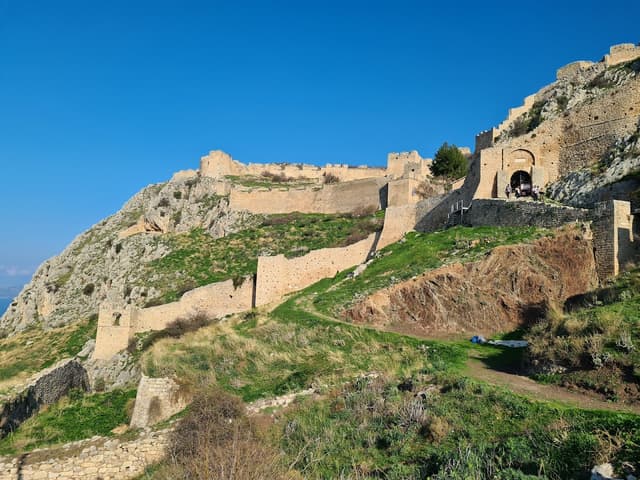
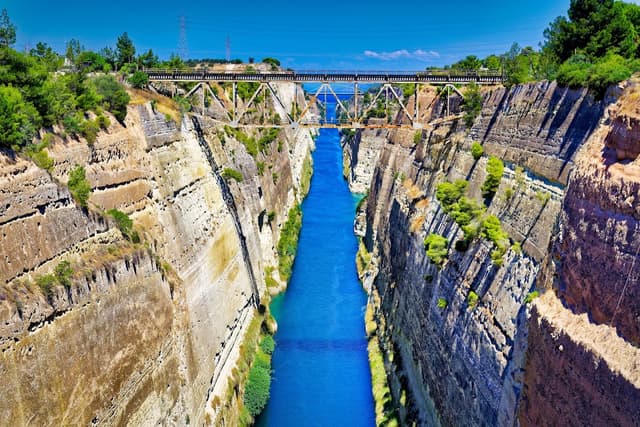
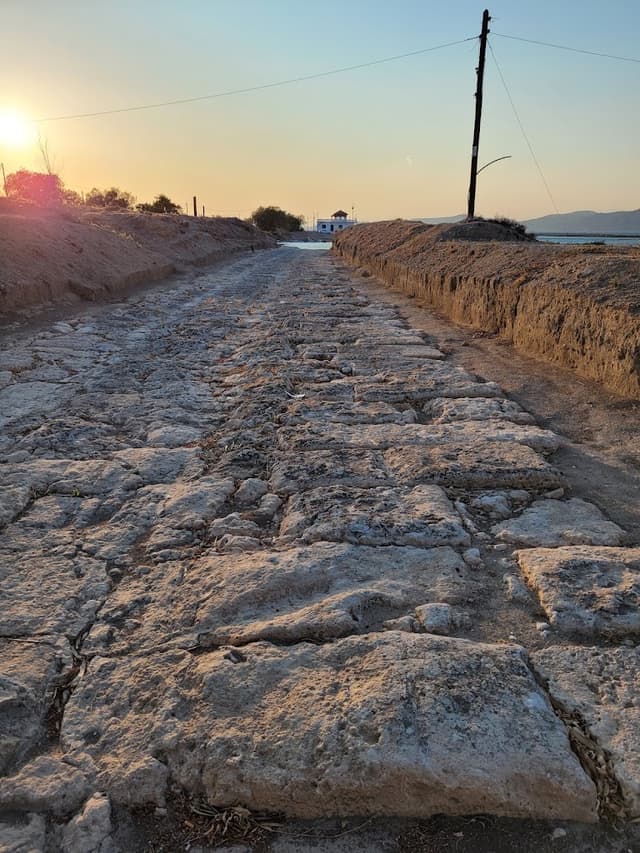
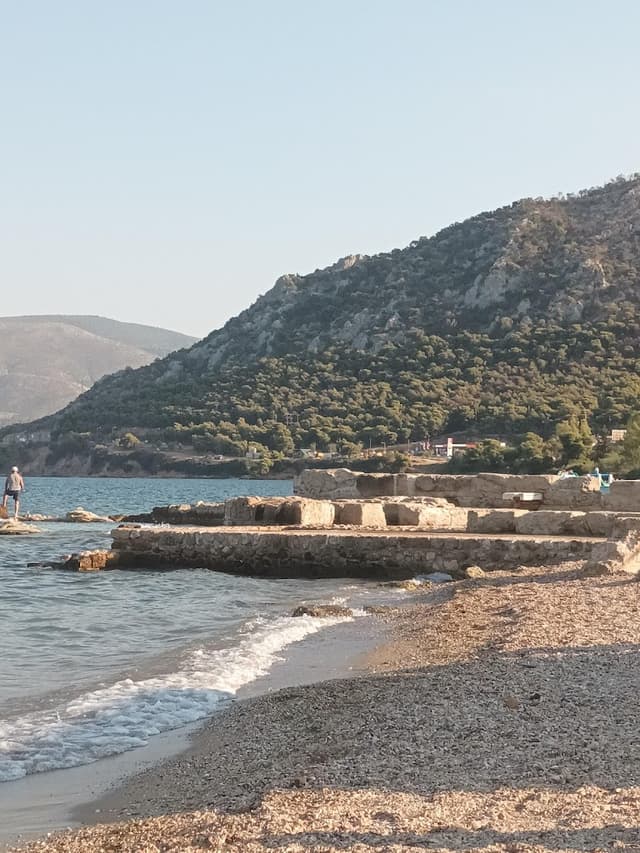
Hotel Recommendation
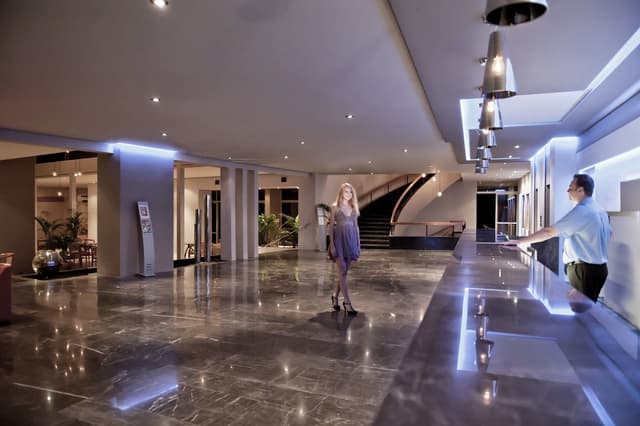
The home for unique & authentic travel